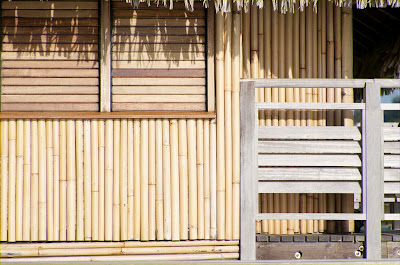I shot this image with a 11mm at F16 to get that infinite depth of field effect. Few things had to be fixed on this image. the horizon is not straight, some areas in the flower bush are under exposed and the overall tone is too cold. Then the image can be enhanced with a little bit of additional contrast and sharpness. I used the auto HDR technique described in a previous post creating 7 jpeg images from the raw file exposed from -2 stops to +4 stops. I used them to created a tone-mapped composite with the HDR tools. Then I cropped and rotated the result, worked on the color, contrast and sharpness. I then selected only the flowers to apply some desaturation as I wanted the flowers to be very white. I also used the spot healing tool to remove the few objects floating in the sea. That intermediate result is here.
I then created the logo of the title with text and the symbol for water. My idea was that all text would be white. I then added the month, and the title and story line for each article. With the text just white the lisibility was poor so I added a drop shadow effect on the text layers to have more contrast between the text and the background image. to have a more dynamic composition I changed the font size of the first character of each title and put the beginning of each title on a diagonal from top right to bottom left. I had then to add a barcode. I found an image on the web but that image did not have a price on it . I recreated the price with characters already in the barcode so that the font is the same I created the $ sign using the S and adding a line and I created the U by copying the 0, cutting the top and adding 2 bars. here is the finished barcode. As an afterthought I am not sure $5.95 is expensive enough for the readers targeted by such a luxury magazine...
As a final touch I selected the tip of the roof and pasted it on top of the title. here is the final result
After comments from Jeff I made small corrections: the month title is now smaller. I felt that smaller it was not right to keep it on its own on the left, so I moved it on the right side of the magazine title and removed the shadow effect to make it even more discreet. I also adjusted the kerning of the article titles. especially as the first character is using a bigger font the distance to the next one was too big. here is the corrected version.










































